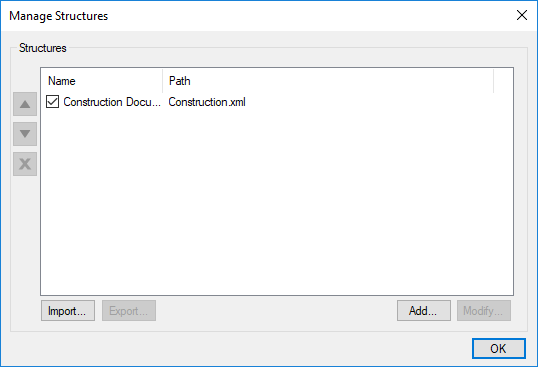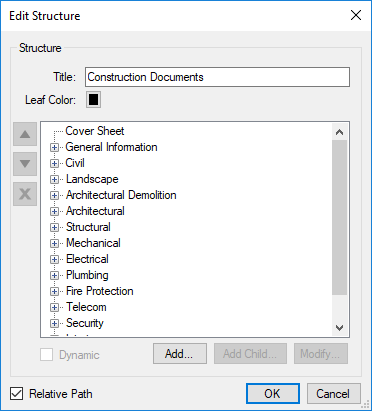Bookmark Structures
Bookmark Structures allow you to predefine bookmark tree structures to match the naming standard that you use. Then you can quickly create the bookmarks from the Structure to complete the bookmarks for your document or drawing set.
Bookmarks retain the tree structure when they are created.
Bookmarks can be defined as dynamic in the structure. The names of dynamic bookmarks are updated when they are created to the next number value. So G-000, G-001, G-002, and so on can be created without having to type the next number.
Note: Structures are only available in Revu eXtreme.
Before you can use a Bookmark Structure on your bookmarks, you will need to set it up. Revu comes with a pre-installed Structure; you might choose to use this one as it is, modify it to suit your specific needs, or create a new one.
Structures are stored as XML files that can be imported and exported or share across a network.
-
Go to Window > Panels >
 Bookmarks or press ALT+B to open the
Bookmarks or press ALT+B to open the  Bookmarks panel.
Bookmarks panel.- It does not matter whether there is a PDF currently open or not.
-
On the Bookmark panel toolbar, go to Bookmarks > Structures > Manage Structures. The Manage Structures dialog box appears.

- To import an existing Structure, click Import, then navigate to the location of the Structure file you wish to import and open it.
- To export an existing Structure, click Export, then navigate to the location where you would like to save the Structure file and save it.
- To create a new Structure:
- Click Add. The Add Structure dialog box appears.
-dialog-box.png)
- Select New.
- Enter a name for the Structure in the Title field.
- To change the default save location for this Structure, click the
 button to the right of the field and select a new location.
button to the right of the field and select a new location. - To use the Full Path to the Structure file, uncheck Relative Path. To use the Relative Path instead, leave this option checked.
- See Working with Bookmarks: Relative and Full Paths for a discussion about Relative versus Full Path.
- Click OK. The Edit Structure dialog box appears. See Editing a Bookmark Structure to continue.
- Click Add. The Add Structure dialog box appears.
- To use a shared Structure:
- Click Add. The Add Structure dialog box appears.
- Select Existing.
- Click the
 button. An Open dialog box appears.
button. An Open dialog box appears. Browse to the location of the shared Structure file and select it. Click Open and the Location is populated.
-dialog-box.png)
- To use the Full Path to the Structure file, uncheck Relative Path. To use the Relative Path instead, leave this option checked.
- See Working with Bookmarks: Relative and Full Paths for a discussion about Relative versus Full Path.
- Click OK.
- To edit an existing Structure:
- Select the desired Structure.
- Click Modify. The Edit Structure dialog box appears. See Editing a Bookmark Structure to continue.
Editing a Structure creates or modifies the structure tree. The structure tree should mirror the way you want bookmarks using the Structure to be created. For example, if you create a branch of your structure tree called "General Information" and it has an object "G-000" under it, creating a bookmark from it will automatically create the bookmark as General Information/G-000.
Creating the structure tree is like creating the bookmarks in a PDF, but without defining the link to the page. The structure tree should contain all of the bookmarks that you might want create in documents that will use the Structure, even if that bookmark is not frequently used.
The Edit Structure dialog box appears when you are creating a new Structure or modifying an existing one (see Working with Bookmark Structures above). It is where the structure tree is defined.

In this dialog box, you can edit the following:
Title: The name of the Structure as it appears within Revu. Enter the desired name in this field.
Leaf Color: The color that will be applied to bookmark names created using the Structure. Click the color box to select a different color.
Dynamic: Determines whether the names of bookmarks created using the currently selected object are static or dynamic. Select this option for dynamic bookmark names. Each individual object in the structure tree is defined as static or dynamic (the default is static).
- Static bookmarks will be created with the exact name that appears in the Structure.
- Dynamic bookmarks can be renamed when they are created. You will have the option to manually rename the bookmark or, if it includes a numeric value, have it automatically proceed to the next, unused name in the sequence. For example, when enabled, the first bookmark created using an object called G-000 will take that name. Subsequent bookmarks created using it will be automatically named "G-001", "G-002", and so on.
Add: Creates a new object in the structure tree at the same level as the one that is currently selected. If none are currently selected, the new object will be at the top-most level.
Add Child: Creates a new object in the structure tree as a child of the one that is currently selected.
Modify: Allows you to change the name of an object in the structure tree. Select the desired object and click this button to make the name editable.
Relative Path: Determines whether bookmarks created using the Structure use a Relative Path or a Full Path. See Working with Bookmarks: Relative and Full Paths for a discussion about Relative versus Full Path.
Use the .png) up,
up, .png) down, and
down, and  delete buttons to reorder or delete structure tree objects.
delete buttons to reorder or delete structure tree objects.
The process for creating bookmarks using a Structure varies slightly depending on whether the bookmark is static or dynamic (see Editing a Bookmark Structure above for more information about static versus dynamic).
- Open the PDF to bookmark.
- Go to Window > Panels >
 Bookmarks or press ALT+B to open the
Bookmarks or press ALT+B to open the  Bookmarks panel.
Bookmarks panel. - On the Bookmark panel toolbar, go to Bookmarks > Structures and select the desired Structure. That structure tree appears.
- Navigate to the desired page of the PDF. Bookmarks are automatically created to the view of the page that is currently in the main workspace.
- To add a static bookmark:
- Hover over the desired object in the structure tree. The
 Add button appears to its right.
Add button appears to its right. - Click the
 Add button. The bookmark appears in the Bookmarks list.
Add button. The bookmark appears in the Bookmarks list.
- Hover over the desired object in the structure tree. The
- To add a dynamic bookmark:
- Hover over the desired object in the structure tree. The
 Add button appears to its right.
Add button appears to its right. - Click the object to make its name editable. Notice that, if it has a numeric value, that the number is automatically updated (unless this is the first time you are creating a bookmark using this object in this PDF).
- Numeric values are automatically increased by adding one to the highest value created using the Structure object. For example, if you have a dynamic object called G-000 and you have already created "G-000", "G-001", and "G-003", the next bookmark would automatically be named "G-004". If you wanted it to be named something else ("G-002", for example), you would need to edit the name manually as described in the next step.
- To enter a name manually for this bookmark, change the current name as desired and press ENTER. The bookmark appears in the Bookmarks list.
- To create the bookmark using the name as it is, click the
 Add button. The bookmark appears in the Bookmarks list.
Add button. The bookmark appears in the Bookmarks list.
- Hover over the desired object in the structure tree. The
- Repeat steps 4-6 as necessary.